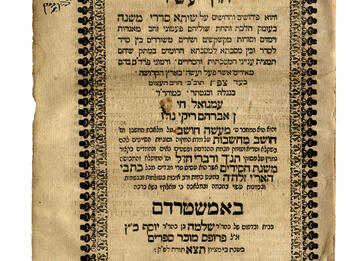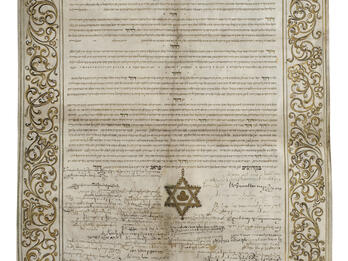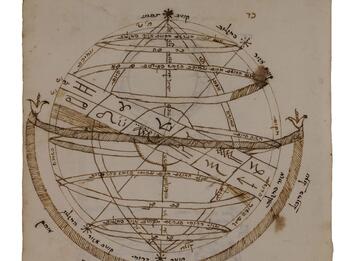Ma‘aseh rokeaḥ (Work of the Perfumer)
Now we come to the clarification of the mishnah: “One may not expound upon forbidden sexual relations to three people”—and the Gemara explains that this is referring to the concealed aspects of forbidden sexual relations, etc.—“nor on the work of creation to two people, nor on the divine chariot by oneself etc.” [m. Ḥagigah 2:1]. As I have already written, this mishnah does not appear to have any connection to the topic of this tractate. Furthermore, why does it first mention the forbidden sexual relations? It should have listed the work of creation and the divine chariot, followed by the forbidden sexual relations, and only then because it is mentioned at the end of the previous chapter [see m. Ḥagigah 1:8].
I therefore maintain that this teaching is essential to the tractate, and that it refers back to the previous chapter, which specified the three offerings that are brought on the pilgrimage festivals: the burnt offerings for appearance; the festival offering; and the offering of rejoicing. As we wrote, these correspond to the three patriarchs. This chapter begins with the last type of offering listed there, as the offering of rejoicing corresponds to Jacob, who married two sisters, Rachel and Leah. Now, how could he have done that? Didn’t the patriarchs observe the entire Torah? And yet he married two sisters, which the Torah would later prohibit. However, the Zohar and the books of the kabbalists, those who follow the secrets of God, explain that the secret of Jacob’s match with Rachel and Leah is the preservation of all the worlds, upper and lower alike, and most of kabbalistic wisdom follows this idea.
Accordingly, the Tanna of the mishnah says that one might wish to expound this secret in public, and he therefore teaches us that “one may not expound upon forbidden sexual relations.” This refers to the genuine concealed aspects of forbidden sexual relations, as the Maharshah wrote in his Ḥidushe agadot [on b. Ḥagigah 11b]. As for “to three people,” this number alludes to the secret of Jacob with Rachel and Leah, or that Jacob himself is considered threefold, as he incorporates kindness, judgment, and mercy, which are the attributes of the three patriarchs. This is the secret of the verse, give truth to Jacob (Micah 7:20), as the [Hebrew] phrase “kindness, judgment, and mercy” has the same numerical value as the word truth, when rounded up.1 This shows that Jacob includes all three. Likewise, you will find that the phrase “to three,” when rounded up, is exactly equal to the numerical value of “Abraham, Isaac, and Jacob.”
Consequently, the Tanna teaches us that one may not expound upon the concealed aspects of forbidden sexual relations, even regarding a secret such as this, where the aim is apparently to justify the righteous, our forefather Jacob, Leah, and Rachel. Nevertheless, one may not expound upon such matters in public; all the more so, one may not expound on the other concealed aspects of forbidden sexual relations. [ . . . ]
Now we come to the clarification of the first mishnah: “Two people holding a robe, etc.” [m. Bava Meẓi‘a 1:1]. Why does the tractate begin with this particular case? The Zohar and the kabbalistic sources that I cited are precise in this regard, as it is stated [Zohar, III, 198a]: for a garment (Exodus 22:8)—this is Bava Meẓi‘a, and this is why the tractate starts with a case involving a robe.
In my opinion, the Tanna of the mishnah is alluding here to the verse: And Shem and Japheth took a garment [and laid it upon both their shoulders, and went backward, and covered the nakedness of their father] (Genesis 9:23). They merited to perform the same mitzvah, and therefore it is they who should rightfully share the reward. However, that was not the case, as Shem alone earned the lion’s share of the reward. Consequently, the Tanna speaks here as though he is raising a difficulty and answering his own question. This is how it is stated in Midrash Rabbah there [Bereshit Rabbah, Noah, par. 36:6, to Genesis 9:23]: And Shem and Japheth took a garment—R. Yoḥanan said: Shem took the initiative in the mitzvah, and Japheth came and listened to him. Therefore, Shem earned a robe [with tzitzit], and Japheth a shawl. The commentaries explain that the midrash derives this idea from a careful reading of the text, as the verb took is in the singular, which implies that Shem began the mitzvah alone, and Japheth merely offered a little assistance. Accordingly, Shem received the robe of a mitzvah while Japheth received only a shawl, which is a decent covering.
All of the above is alluded to in the words of the Tanna here: “Two people holding [shenayam oḥazin]”—these two words have the numerical value of “Shem, son of Noah, and his brother,” when the sum is rounded up; do the calculation yourself and you will find that it is correct. Thus, his words indicate that Shem was the main instigator of the mitzvah while his brother was subordinate to him, and therefore Shem earned the robe. You will also find another wonderful allusion, as the numerical value of robe, when rounded up, is exactly the same as the numerical value of Shem, son of Noah. However, if two people are holding the garment equally, it is indeed right that they should share.
It is possible that this is also the meaning of the statement of the holy Zohar: “for a garment (Exodus 22:8)—this is Bava Meẓi‘a,” and this is why the tractate starts with a case involving a robe. For when you calculate the phrase “for a garment,” with the letters, and round it up, you will find it is the same sum as the phrase “Shem, son of Noah, merited.”
This is why the tractate begins with this case, as I have already written that the secret of Bava Meẓi‘a is the six edges, from ḥesed [“mercy”; the fourth sefirah] to yesod [“foundation”; the ninth sefirah],2 and it is well-known that the priest is represented by the mode of ḥesed. Now, Shem, son of Noah, was a priest, even though the priesthood was later taken from him and given to Abraham. Therefore, the tractate starts with Shem, son of Noah, as he operated through the attribute of ḥesed. Examine this matter carefully, and you will understand it.
Next, chapter 2 starts with the phrase: “These are the findings that one may keep.” This alludes to the midrash [Bereshit Rabbah, Bereshit, par.29:3, to Genesis 6:8] that the Holy One, blessed be He, found three items: Abraham, as it is written: and You found his heart faithful before You (Nehemiah 9:8); Israel, as it is written: I found Israel like grapes in the wilderness (Hosea 9:10); and David, as it is written: I found David My servant (Psalms 89:21). If you calculate the three words elu metsi’ot shelo [these are the findings that one may keep], you will find that they have the same numerical value as “Abraham, Israel, King David,” with the letters and the words, and rounded up; or, if you write it like this: “Abraham, Israel, and King David,”3 the sum is exact.
Translated by
.
Notes
[That is, when the numerical value is off by one (as is the case here), the two sums can still be considered equal, as an extra number is ascribed to the phrase or word itself.—Trans.]
[I.e., the six lower sefirot, or modes of God, that correspond to the four directions of the compass, plus the directions of upward and downward. They are ḥesed (mercy), gevurah or din (strength or justice), tif’eret (beauty), netsaḥ (eternity), hod (glory), and yesod (foundation).—Trans.]
[With an extra letter yod in the name David, as it is spelled in Chronicles.—Trans.]
Credits
Eleazar Rokeaḥ Ma‘aseh rokeaḥ (Work of the Ointment Maker) (Amsterdam: Yosef Dayan Mizuyan, 1740), 51b–52a, 77b–78a.
Published in: The Posen Library of Jewish Culture and Civilization, vol. 5.






